2025秋高考英语复习基础语法专题二句法第1讲定语从句课件
文档属性
| 名称 | 2025秋高考英语复习基础语法专题二句法第1讲定语从句课件 |  | |
| 格式 | ppt | ||
| 文件大小 | 396.0KB | ||
| 资源类型 | 试卷 | ||
| 版本资源 | 通用版 | ||
| 科目 | 英语 | ||
| 更新时间 | 2025-06-09 12:30:15 | ||
图片预览

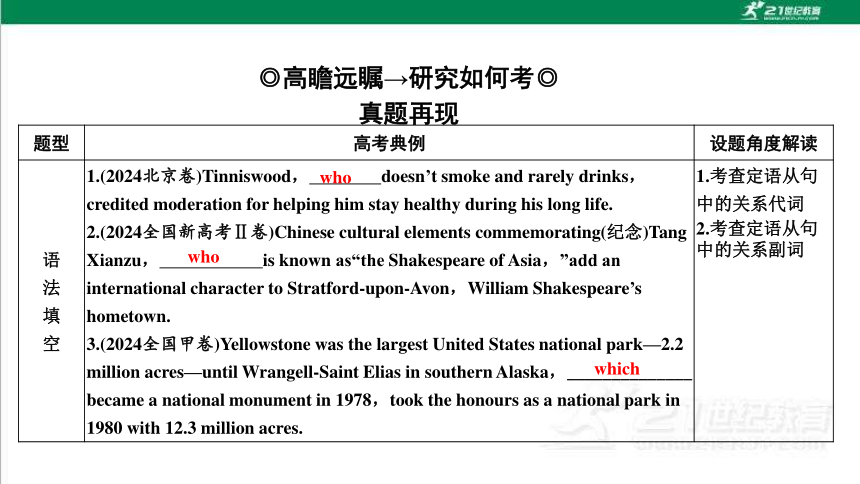
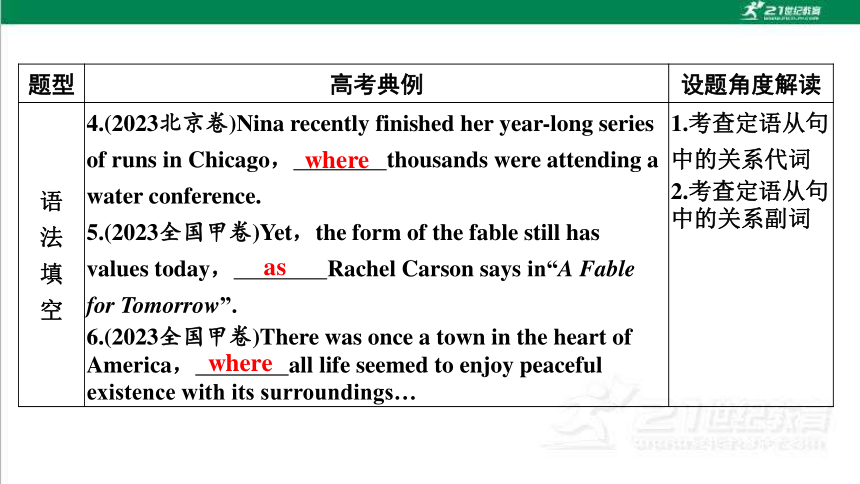
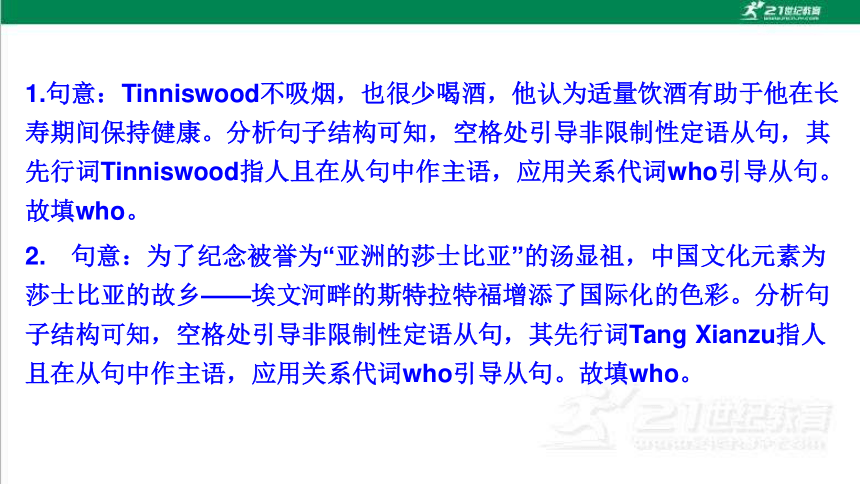

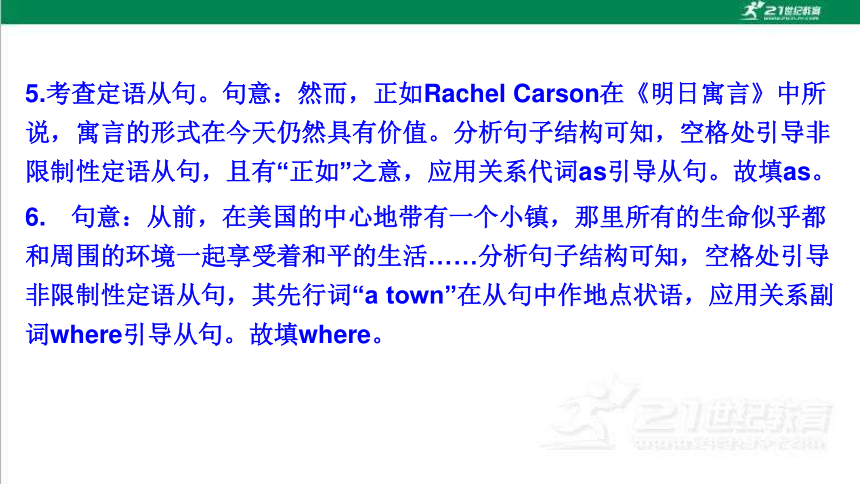

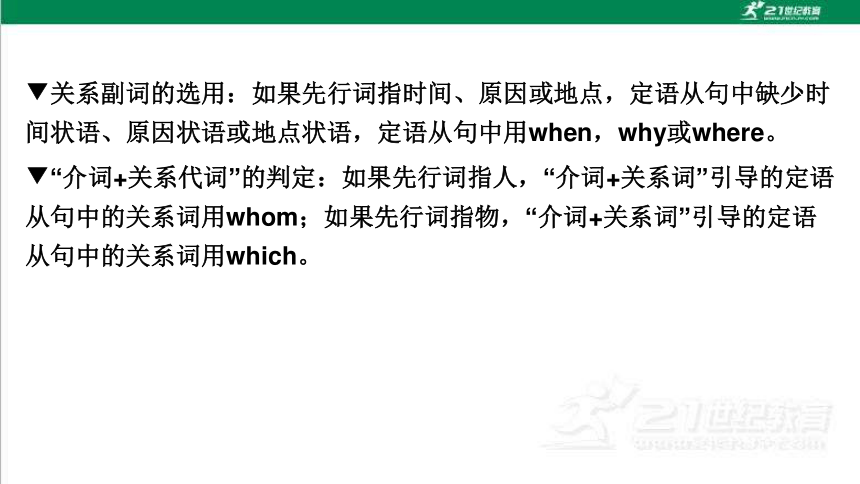

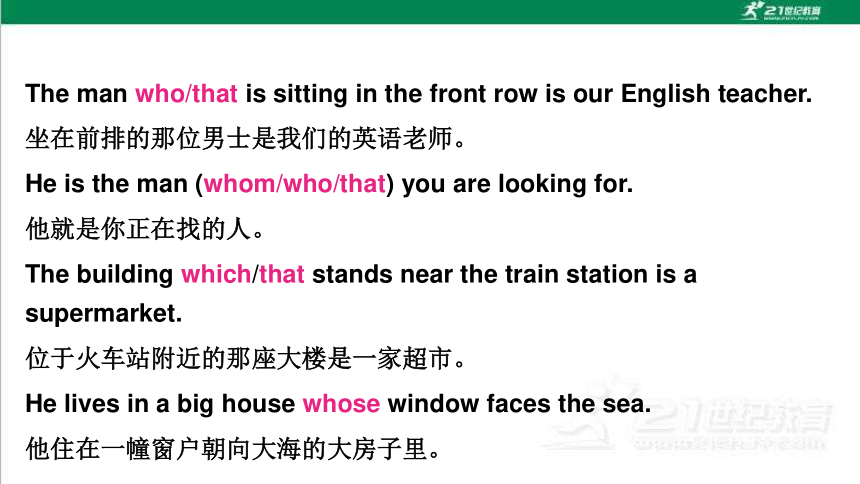

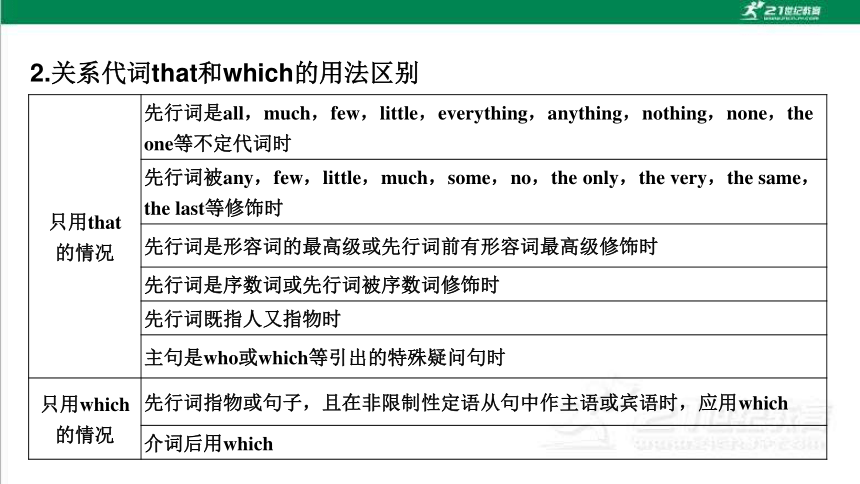
文档简介
(共36张PPT)
专题二 句法篇
第1讲 定语从句
◎高瞻远瞩→研究如何考◎
真题再现
题型 高考典例 设题角度解读
语
法
填
空 1.(2024北京卷)Tinniswood, doesn’t smoke and rarely drinks,credited moderation for helping him stay healthy during his long life.
2.(2024全国新高考Ⅱ卷)Chinese cultural elements commemorating(纪念)Tang Xianzu, is known as“the Shakespeare of Asia,”add an international character to Stratford-upon-Avon,William Shakespeare’s hometown.
3.(2024全国甲卷)Yellowstone was the largest United States national park—2.2 million acres—until Wrangell-Saint Elias in southern Alaska,______________ became a national monument in 1978,took the honours as a national park in 1980 with 12.3 million acres. 1.考查定语从句中的关系代词
2.考查定语从句中的关系副词
who
who
which
题型 高考典例 设题角度解读
语
法
填
空 4.(2023北京卷)Nina recently finished her year-long series of runs in Chicago, thousands were attending a water conference.
5.(2023全国甲卷)Yet,the form of the fable still has values today, Rachel Carson says in“A Fable for Tomorrow”.
6.(2023全国甲卷)There was once a town in the heart of America, all life seemed to enjoy peaceful existence with its surroundings… 1.考查定语从句中的关系代词
2.考查定语从句中的关系副词
where
as
where
1.句意:Tinniswood不吸烟,也很少喝酒,他认为适量饮酒有助于他在长寿期间保持健康。分析句子结构可知,空格处引导非限制性定语从句,其先行词Tinniswood指人且在从句中作主语,应用关系代词who引导从句。故填who。
2. 句意:为了纪念被誉为“亚洲的莎士比亚”的汤显祖,中国文化元素为莎士比亚的故乡——埃文河畔的斯特拉特福增添了国际化的色彩。分析句子结构可知,空格处引导非限制性定语从句,其先行词Tang Xianzu指人且在从句中作主语,应用关系代词who引导从句。故填who。
3. 句意:黄石公园是美国最大的国家公园,占地220万英亩,直到1978年成为国家纪念碑的阿拉斯加南部的弗兰格尔——圣伊莱亚斯在1980年以1230万英亩的面积作为国家公园获得这项荣誉。分析句子结构可知,空格处引导非限制性定语从句,其先行词Wrangell-Saint Elias指物且在从句中作主语,应用关系代词which引导从句。故填which。
4. 句意:最近,Nina在芝加哥结束了长达一年的系列跑步活动,数千人在那里参加了一个水的会议。分析句子结构可知, 空格处引导非限制性定语从句,其先行词Chicago在从句中作地点状语,应用关系副词where引导从句。故填where。
5.考查定语从句。句意:然而,正如Rachel Carson在《明日寓言》中所说,寓言的形式在今天仍然具有价值。分析句子结构可知,空格处引导非限制性定语从句,且有“正如”之意,应用关系代词as引导从句。故填as。
6. 句意:从前,在美国的中心地带有一个小镇,那里所有的生命似乎都和周围的环境一起享受着和平的生活……分析句子结构可知,空格处引导非限制性定语从句,其先行词“a town”在从句中作地点状语,应用关系副词where引导从句。故填where。
解题策略
▼关系代词的选用:
1.如果先行词指人,定语从句中缺少主语,限制性定语从句中用who/that;非限制性定语从句中用who;
2.如果先行词指人,定语从句中缺少宾语,限制性定语从句中用who/that/whom;非限制性定语从句中用whom;
3.如果先行词指物,定语从句中缺少主语或宾语,限制性定语从句中用which/that;非限制性定语从句中用which。
▼关系副词的选用:如果先行词指时间、原因或地点,定语从句中缺少时间状语、原因状语或地点状语,定语从句中用when,why或where。
▼“介词+关系代词”的判定:如果先行词指人,“介词+关系词”引导的定语从句中的关系词用whom;如果先行词指物,“介词+关系词”引导的定语从句中的关系词用which。
关系代词的用法
1.引导定语从句的常用关系代词
◎核心精讲→归纳如何学◎
关系代词 先行词 在从句中的成分
who 人 主语、宾语
whom 人 宾语
that 人或物 主语、宾语、表语
which 物 主语、宾语
whose 人或物 定语
as 人或物 主语、宾语、表语
The man who/that is sitting in the front row is our English teacher.
坐在前排的那位男士是我们的英语老师。
He is the man (whom/who/that) you are looking for.
他就是你正在找的人。
The building which/that stands near the train station is a supermarket.
位于火车站附近的那座大楼是一家超市。
He lives in a big house whose window faces the sea.
他住在一幢窗户朝向大海的大房子里。
Taiwan is, as you know, an inseparable part of China.
正如你们所知道的,台湾是中国不可分割的一部分。
In the last exam, he made the same mistake as you made.
在上次考试中,他犯了一个与你相同的错误。
2.关系代词that和which的用法区别
只用that
的情况 先行词是all,much,few,little,everything,anything,nothing,none,the one等不定代词时
先行词被any,few,little,much,some,no,the only,the very,the same,the last等修饰时
先行词是形容词的最高级或先行词前有形容词最高级修饰时
先行词是序数词或先行词被序数词修饰时
先行词既指人又指物时
主句是who或which等引出的特殊疑问句时
只用which
的情况 先行词指物或句子,且在非限制性定语从句中作主语或宾语时,应用which
介词后用which
We should do everything that is beneficial to the people.
我们应该做一切有益于人民的事。
This is the smallest computer that can be found in the world now.
这是目前发现的世界上最小的计算机。
I bought a great many books,on which I spent all my money I saved.
我买了很多书,它们花光了我所有的积蓄。
关系副词的用法
关系副词 先行词 在从句中
的成分
when 时间名词 时间状语
where 地点名词或抽象名词(situation,case,point, stage,circumstance等) 地点状语
why the reason 原因状语
I will never forget the day when (=on which) we moved into our new house.
我永远不会忘记我们搬进新居的那一天。
Students should involve themselves in community activities where (=in which) they can gain experience for growth.
学生们应该参与社团活动,在这些活动中他们可以获得成长的经验。
He didn’t know the reason why (=for which) he was dismissed.
他不知道被解雇的原因。
“介词+关系代词”引导的定语从句
1.“介词+关系代词”结构中介词的确定方法:
方法一:根据定语从句中的谓语动词或主要的形容词确定介词。
方法二:根据定语从句修饰的先行词确定介词。
方法三:根据句子所要表达的意思确定介词。
Galileo’s ideas were well in advance of the age in which he lived.
伽利略的思想远远超越了他所处的时代。
I don’t know the reason for which he was late for school.
我不知道他为何上学迟到。
This is the pilot by whom my son was saved.
这就是那位救了我儿子的飞行员。
2.“介词+关系代词”引导的定语从句注意事项:
(1)“介词+关系代词”结构中的关系代词通常用which或whom。
I’ll never forget the day on which I joined the army.
我永远也忘不了我参军的那一天。
Do you know the man to/with whom Mr Black talked just now?
你认识刚和布莱克先生谈话的那个人吗?
(2)关系副词where, when, why可替换成“介词+which”,介词取决于先行词及“介词+which”在从句中的作用。why只可用for which替换。
This is the house where I lived two years ago.
=This is the house in which I lived two years ago.
这就是两年前我居住的那套房子。
(3)“不定代词或数词+of+which/whom”引导的定语从句用来说明整体中的部分情况。
Last week, only two people came to look at the house,neither of whom wanted to buy it.
上周只有两个人来看房子,他们两个人都不想买。
(4)“the+名词+of which”或“of which+the+名词”可替换为“whose+名词+从句”。
The house the windows of which/of which the windows/whose windows were damaged has now been repaired.
窗子遭破坏的那间房子现在已经修好了。
限制性定语从句与非限制性定语从句
1.限制性定语从句与非限制性定语从句的区别
限制性定语从句 非限制性定语从句
和先行词的关系密切(删除后影响整个句子意义的表达) 和先行词关系不密切(起补充说明的作用,删掉后不影响句意)
不用逗号隔开 一般用逗号隔开
可用所有引导词引导 不可以用that引导
只可以修饰先行词,不可以修饰主句或主句的一部分 既可以修饰先行词,也可以修饰主句或主句的一部分
He is the man who/that came to visit you yesterday.
他是昨天来看望你的那个人。
The sports meeting was put off,which astonished us.
运动会推迟了,这让我们很吃惊。
2.as/which引导的非限制性定语从句的区别
as 引导非限制性定语从句时,指代整句话或整件事。 可放在主句前、中、后,as常译为“正如;正像”。从句的谓语动词多为see,know,expect,say,mention,report等。
which 引导非限制性定语从句时,指代整句话或整件事,也可指代先行词。 只能置于主句后,常译为“这”,which引导的从句与主句之间常含有并列或因果关系。
As we all know,smoking is harmful to health.
我们都知道,吸烟有害健康。
He finished the task ahead of time, which is very important to us.
他提前完成了任务,这对我们很重要。
3.非限制性定语从句与并列句的区别
非限制性定语从句与主句之间常用逗号分开,并且不能加入and, but, so, or等连词,而并列句一般用and, but, so, or等词连接。
He paid the boy $10 for washing the windows, most of which hadn’t been cleaned for at least a year.
=He paid the boy $10 for washing the windows,and most of them hadn’t been cleaned for at least a year.
=He paid the boy $10 for washing the windows.Most of them hadn’t been cleaned for at least a year.
他付给那个男孩10美元洗窗户,大部分窗户至少有一年没擦了。
Ⅰ.单句语法填空
1.(2024全国新高考Ⅰ卷改编)According to this theory, people approach digital texts with a mindset suited to social media, are often not so serious, and devote less mental effort than they are reading print.
2.(2024浙江1月卷改编)One doubter about the safety of cloud seeding is Chuck Doswell, a research scientist just retired from the University of Oklahoma.
◎冲关训练→专练如何解◎
which
who/that
1.句意:根据这一理论,人们以适合社交媒体的心态接近数字文本,这些文本通常不那么严肃,投入的心理努力比在阅读印刷品时要少。分析句子结构可知,空格处引导非限制性定语从句,其先行词“digital texts”指物且在从句中作主语,应用关系代词which引导从句。故填which。
2. 句意:Chuck Doswell是一位刚刚从俄克拉荷马大学退休的研究科学家,他对人工降雨的安全性持怀疑态度。分析句子结构可知,空格处引导定语从句,其先行词“a research scientist”指人且在从句中作主语,应用关系代词who/that引导从句。故填who/that。
3.If I learned of a company used a lot of plastic, I’d send it an email urging it to cut back.
4.Southbank, at an eastern bend in the Thames, is the centre of British skateboarding, the continuous crashing of skateboards left your head ringing.
5.In our factory there are 2,000 workers, two thirds of are women.
that/which
where
whom
3.句意:如果我知道有哪家公司大量使用塑料,我就给它发邮件,敦促它减少使用塑料。分析句子结构可知,空格处引导定语从句,其先行词“a company”指物且在从句中作主语,应用that/which引导从句。故填that/which。
4. 句意:泰晤士河东岸的南岸,是英国的滑板中心,在这里,滑板不断的碰撞声让你的脑袋嗡嗡作响。分析句子结构可知,空格处引导非限制性定语从句,其先行词“the centre of British skateboarding”在从句中作地点状语,应用关系副词where引导从句。故填where。
6. is reported, Sophia is a great teacher because she really relates to the kids.
7.I don’t know the reason you were absent from the meeting, but I am sure that someone will tell me the reason you haven’t told me.
8.The school is no longer what it was 20 years ago, it was so poorly equipped.
As
why
that/which
when
5. 句意:在我们的工厂里有2000名工人,其中三分之二是妇女。分析句子结构可知,空格处引导非限制性定语从句,其先行词workers指人且在从句中作介词of的宾语,应用关系代词whom引导从句。故填whom。
6.句意:正如所报道的那样,Sophia是一位好老师,因为她真的理解孩子们。分析句子结构并结合语境可知,空格处指代后面的整个句子,表示“正如所报道的那样”,应用as引导从句。此处位于句首,首字母应大写。故填As。
7. 句意:我不知道你缺席会议的理由,但是一定会有人告诉我你没告诉我的理由。分析句子结构可知,第一个空格引导定语从句,其先行词“the reason”在从句中作原因状语,应用关系副词why引导从句;第二个空格也引导定语从句,其先行词“the reason”指物且在从句中作宾语,应用关系代词that/which引导从句。故填why; that/which。
8.句意:学校已经不是20年前的样子了,当时它的设备很差。分析句子结构可知,空格处引导非限制性定语从句,其先行词“20 years ago”在从句中作时间状语,应用关系副词when引导从句。故填when。
9.Many lessons are now available online, from students can choose for free.
10.Dr Rowan, secretary resigned two weeks ago, has had to do all his own typing.
which
whose
9.句意:许多课程现在都可以在网上找到,学生们可以从中免费选择。分析句子结构可知,空格处引导非限制性定语从句,其先行词“many lessons”指物且在从句中作介词from的宾语,应用关系代词which引导从句。故填which。
10.句意:Rowan博士的秘书两周前辞职了,他现在只能自己打字。分析句子结构可知,空格处引导非限制性定语从句,其先行词Dr Rowan指人且在从句中作定语,应用关系代词whose引导从句。故填whose。
Ⅱ.语法填空
Hao Liyan, 1. was trained as an architect, seemed born for a career in building or design. And he found his true interest in life: running a business hand-made toys 2. use traditional Chinese mortise-and-tenon(榫卯) joints.
“I had seen all the hard work and injuries 3. my ancestors had and decided against following in their footsteps,” the 42-year-old says. “But growing up, I understood the value of the skills and felt it a duty to preserve these skills. The culture of a family 4. is rooted in our hearts deeply influences who we become.”
who
that/which
that/which
that/which
This technique, 5. is called sunmao in Chinese, joins wood pieces together by fitting them like puzzle pieces. Without using nails or glue, the system creates strong, interlocking structures 6. are built to last. Tracing its roots to the Neolithic period, the skill is celebrated as a part of China’s cultural heritage.
Sunmao, 7. peaked during the Ming and Qing dynasties, was necessary for constructing everything from grand palaces to complex furniture and musical instruments. With modernisation over the centuries, however, the technique declined. The reason 8. this happened was that cheaper, less labour-intensive materials became popular.
which
that/which
which
why
But now, this ancient technique has found new life among a cultural return 9. celebrates traditional Chinese elements in contemporary design. Named guochao — or “China chic” — this movement has grown popular among the nation’s younger generations, especially those 10. are called Gen Z.
“By connecting past and present, we’re sure that never will these age-old skills be forgotten,” Hao says.
that/which
who
专题二 句法篇
第1讲 定语从句
◎高瞻远瞩→研究如何考◎
真题再现
题型 高考典例 设题角度解读
语
法
填
空 1.(2024北京卷)Tinniswood, doesn’t smoke and rarely drinks,credited moderation for helping him stay healthy during his long life.
2.(2024全国新高考Ⅱ卷)Chinese cultural elements commemorating(纪念)Tang Xianzu, is known as“the Shakespeare of Asia,”add an international character to Stratford-upon-Avon,William Shakespeare’s hometown.
3.(2024全国甲卷)Yellowstone was the largest United States national park—2.2 million acres—until Wrangell-Saint Elias in southern Alaska,______________ became a national monument in 1978,took the honours as a national park in 1980 with 12.3 million acres. 1.考查定语从句中的关系代词
2.考查定语从句中的关系副词
who
who
which
题型 高考典例 设题角度解读
语
法
填
空 4.(2023北京卷)Nina recently finished her year-long series of runs in Chicago, thousands were attending a water conference.
5.(2023全国甲卷)Yet,the form of the fable still has values today, Rachel Carson says in“A Fable for Tomorrow”.
6.(2023全国甲卷)There was once a town in the heart of America, all life seemed to enjoy peaceful existence with its surroundings… 1.考查定语从句中的关系代词
2.考查定语从句中的关系副词
where
as
where
1.句意:Tinniswood不吸烟,也很少喝酒,他认为适量饮酒有助于他在长寿期间保持健康。分析句子结构可知,空格处引导非限制性定语从句,其先行词Tinniswood指人且在从句中作主语,应用关系代词who引导从句。故填who。
2. 句意:为了纪念被誉为“亚洲的莎士比亚”的汤显祖,中国文化元素为莎士比亚的故乡——埃文河畔的斯特拉特福增添了国际化的色彩。分析句子结构可知,空格处引导非限制性定语从句,其先行词Tang Xianzu指人且在从句中作主语,应用关系代词who引导从句。故填who。
3. 句意:黄石公园是美国最大的国家公园,占地220万英亩,直到1978年成为国家纪念碑的阿拉斯加南部的弗兰格尔——圣伊莱亚斯在1980年以1230万英亩的面积作为国家公园获得这项荣誉。分析句子结构可知,空格处引导非限制性定语从句,其先行词Wrangell-Saint Elias指物且在从句中作主语,应用关系代词which引导从句。故填which。
4. 句意:最近,Nina在芝加哥结束了长达一年的系列跑步活动,数千人在那里参加了一个水的会议。分析句子结构可知, 空格处引导非限制性定语从句,其先行词Chicago在从句中作地点状语,应用关系副词where引导从句。故填where。
5.考查定语从句。句意:然而,正如Rachel Carson在《明日寓言》中所说,寓言的形式在今天仍然具有价值。分析句子结构可知,空格处引导非限制性定语从句,且有“正如”之意,应用关系代词as引导从句。故填as。
6. 句意:从前,在美国的中心地带有一个小镇,那里所有的生命似乎都和周围的环境一起享受着和平的生活……分析句子结构可知,空格处引导非限制性定语从句,其先行词“a town”在从句中作地点状语,应用关系副词where引导从句。故填where。
解题策略
▼关系代词的选用:
1.如果先行词指人,定语从句中缺少主语,限制性定语从句中用who/that;非限制性定语从句中用who;
2.如果先行词指人,定语从句中缺少宾语,限制性定语从句中用who/that/whom;非限制性定语从句中用whom;
3.如果先行词指物,定语从句中缺少主语或宾语,限制性定语从句中用which/that;非限制性定语从句中用which。
▼关系副词的选用:如果先行词指时间、原因或地点,定语从句中缺少时间状语、原因状语或地点状语,定语从句中用when,why或where。
▼“介词+关系代词”的判定:如果先行词指人,“介词+关系词”引导的定语从句中的关系词用whom;如果先行词指物,“介词+关系词”引导的定语从句中的关系词用which。
关系代词的用法
1.引导定语从句的常用关系代词
◎核心精讲→归纳如何学◎
关系代词 先行词 在从句中的成分
who 人 主语、宾语
whom 人 宾语
that 人或物 主语、宾语、表语
which 物 主语、宾语
whose 人或物 定语
as 人或物 主语、宾语、表语
The man who/that is sitting in the front row is our English teacher.
坐在前排的那位男士是我们的英语老师。
He is the man (whom/who/that) you are looking for.
他就是你正在找的人。
The building which/that stands near the train station is a supermarket.
位于火车站附近的那座大楼是一家超市。
He lives in a big house whose window faces the sea.
他住在一幢窗户朝向大海的大房子里。
Taiwan is, as you know, an inseparable part of China.
正如你们所知道的,台湾是中国不可分割的一部分。
In the last exam, he made the same mistake as you made.
在上次考试中,他犯了一个与你相同的错误。
2.关系代词that和which的用法区别
只用that
的情况 先行词是all,much,few,little,everything,anything,nothing,none,the one等不定代词时
先行词被any,few,little,much,some,no,the only,the very,the same,the last等修饰时
先行词是形容词的最高级或先行词前有形容词最高级修饰时
先行词是序数词或先行词被序数词修饰时
先行词既指人又指物时
主句是who或which等引出的特殊疑问句时
只用which
的情况 先行词指物或句子,且在非限制性定语从句中作主语或宾语时,应用which
介词后用which
We should do everything that is beneficial to the people.
我们应该做一切有益于人民的事。
This is the smallest computer that can be found in the world now.
这是目前发现的世界上最小的计算机。
I bought a great many books,on which I spent all my money I saved.
我买了很多书,它们花光了我所有的积蓄。
关系副词的用法
关系副词 先行词 在从句中
的成分
when 时间名词 时间状语
where 地点名词或抽象名词(situation,case,point, stage,circumstance等) 地点状语
why the reason 原因状语
I will never forget the day when (=on which) we moved into our new house.
我永远不会忘记我们搬进新居的那一天。
Students should involve themselves in community activities where (=in which) they can gain experience for growth.
学生们应该参与社团活动,在这些活动中他们可以获得成长的经验。
He didn’t know the reason why (=for which) he was dismissed.
他不知道被解雇的原因。
“介词+关系代词”引导的定语从句
1.“介词+关系代词”结构中介词的确定方法:
方法一:根据定语从句中的谓语动词或主要的形容词确定介词。
方法二:根据定语从句修饰的先行词确定介词。
方法三:根据句子所要表达的意思确定介词。
Galileo’s ideas were well in advance of the age in which he lived.
伽利略的思想远远超越了他所处的时代。
I don’t know the reason for which he was late for school.
我不知道他为何上学迟到。
This is the pilot by whom my son was saved.
这就是那位救了我儿子的飞行员。
2.“介词+关系代词”引导的定语从句注意事项:
(1)“介词+关系代词”结构中的关系代词通常用which或whom。
I’ll never forget the day on which I joined the army.
我永远也忘不了我参军的那一天。
Do you know the man to/with whom Mr Black talked just now?
你认识刚和布莱克先生谈话的那个人吗?
(2)关系副词where, when, why可替换成“介词+which”,介词取决于先行词及“介词+which”在从句中的作用。why只可用for which替换。
This is the house where I lived two years ago.
=This is the house in which I lived two years ago.
这就是两年前我居住的那套房子。
(3)“不定代词或数词+of+which/whom”引导的定语从句用来说明整体中的部分情况。
Last week, only two people came to look at the house,neither of whom wanted to buy it.
上周只有两个人来看房子,他们两个人都不想买。
(4)“the+名词+of which”或“of which+the+名词”可替换为“whose+名词+从句”。
The house the windows of which/of which the windows/whose windows were damaged has now been repaired.
窗子遭破坏的那间房子现在已经修好了。
限制性定语从句与非限制性定语从句
1.限制性定语从句与非限制性定语从句的区别
限制性定语从句 非限制性定语从句
和先行词的关系密切(删除后影响整个句子意义的表达) 和先行词关系不密切(起补充说明的作用,删掉后不影响句意)
不用逗号隔开 一般用逗号隔开
可用所有引导词引导 不可以用that引导
只可以修饰先行词,不可以修饰主句或主句的一部分 既可以修饰先行词,也可以修饰主句或主句的一部分
He is the man who/that came to visit you yesterday.
他是昨天来看望你的那个人。
The sports meeting was put off,which astonished us.
运动会推迟了,这让我们很吃惊。
2.as/which引导的非限制性定语从句的区别
as 引导非限制性定语从句时,指代整句话或整件事。 可放在主句前、中、后,as常译为“正如;正像”。从句的谓语动词多为see,know,expect,say,mention,report等。
which 引导非限制性定语从句时,指代整句话或整件事,也可指代先行词。 只能置于主句后,常译为“这”,which引导的从句与主句之间常含有并列或因果关系。
As we all know,smoking is harmful to health.
我们都知道,吸烟有害健康。
He finished the task ahead of time, which is very important to us.
他提前完成了任务,这对我们很重要。
3.非限制性定语从句与并列句的区别
非限制性定语从句与主句之间常用逗号分开,并且不能加入and, but, so, or等连词,而并列句一般用and, but, so, or等词连接。
He paid the boy $10 for washing the windows, most of which hadn’t been cleaned for at least a year.
=He paid the boy $10 for washing the windows,and most of them hadn’t been cleaned for at least a year.
=He paid the boy $10 for washing the windows.Most of them hadn’t been cleaned for at least a year.
他付给那个男孩10美元洗窗户,大部分窗户至少有一年没擦了。
Ⅰ.单句语法填空
1.(2024全国新高考Ⅰ卷改编)According to this theory, people approach digital texts with a mindset suited to social media, are often not so serious, and devote less mental effort than they are reading print.
2.(2024浙江1月卷改编)One doubter about the safety of cloud seeding is Chuck Doswell, a research scientist just retired from the University of Oklahoma.
◎冲关训练→专练如何解◎
which
who/that
1.句意:根据这一理论,人们以适合社交媒体的心态接近数字文本,这些文本通常不那么严肃,投入的心理努力比在阅读印刷品时要少。分析句子结构可知,空格处引导非限制性定语从句,其先行词“digital texts”指物且在从句中作主语,应用关系代词which引导从句。故填which。
2. 句意:Chuck Doswell是一位刚刚从俄克拉荷马大学退休的研究科学家,他对人工降雨的安全性持怀疑态度。分析句子结构可知,空格处引导定语从句,其先行词“a research scientist”指人且在从句中作主语,应用关系代词who/that引导从句。故填who/that。
3.If I learned of a company used a lot of plastic, I’d send it an email urging it to cut back.
4.Southbank, at an eastern bend in the Thames, is the centre of British skateboarding, the continuous crashing of skateboards left your head ringing.
5.In our factory there are 2,000 workers, two thirds of are women.
that/which
where
whom
3.句意:如果我知道有哪家公司大量使用塑料,我就给它发邮件,敦促它减少使用塑料。分析句子结构可知,空格处引导定语从句,其先行词“a company”指物且在从句中作主语,应用that/which引导从句。故填that/which。
4. 句意:泰晤士河东岸的南岸,是英国的滑板中心,在这里,滑板不断的碰撞声让你的脑袋嗡嗡作响。分析句子结构可知,空格处引导非限制性定语从句,其先行词“the centre of British skateboarding”在从句中作地点状语,应用关系副词where引导从句。故填where。
6. is reported, Sophia is a great teacher because she really relates to the kids.
7.I don’t know the reason you were absent from the meeting, but I am sure that someone will tell me the reason you haven’t told me.
8.The school is no longer what it was 20 years ago, it was so poorly equipped.
As
why
that/which
when
5. 句意:在我们的工厂里有2000名工人,其中三分之二是妇女。分析句子结构可知,空格处引导非限制性定语从句,其先行词workers指人且在从句中作介词of的宾语,应用关系代词whom引导从句。故填whom。
6.句意:正如所报道的那样,Sophia是一位好老师,因为她真的理解孩子们。分析句子结构并结合语境可知,空格处指代后面的整个句子,表示“正如所报道的那样”,应用as引导从句。此处位于句首,首字母应大写。故填As。
7. 句意:我不知道你缺席会议的理由,但是一定会有人告诉我你没告诉我的理由。分析句子结构可知,第一个空格引导定语从句,其先行词“the reason”在从句中作原因状语,应用关系副词why引导从句;第二个空格也引导定语从句,其先行词“the reason”指物且在从句中作宾语,应用关系代词that/which引导从句。故填why; that/which。
8.句意:学校已经不是20年前的样子了,当时它的设备很差。分析句子结构可知,空格处引导非限制性定语从句,其先行词“20 years ago”在从句中作时间状语,应用关系副词when引导从句。故填when。
9.Many lessons are now available online, from students can choose for free.
10.Dr Rowan, secretary resigned two weeks ago, has had to do all his own typing.
which
whose
9.句意:许多课程现在都可以在网上找到,学生们可以从中免费选择。分析句子结构可知,空格处引导非限制性定语从句,其先行词“many lessons”指物且在从句中作介词from的宾语,应用关系代词which引导从句。故填which。
10.句意:Rowan博士的秘书两周前辞职了,他现在只能自己打字。分析句子结构可知,空格处引导非限制性定语从句,其先行词Dr Rowan指人且在从句中作定语,应用关系代词whose引导从句。故填whose。
Ⅱ.语法填空
Hao Liyan, 1. was trained as an architect, seemed born for a career in building or design. And he found his true interest in life: running a business hand-made toys 2. use traditional Chinese mortise-and-tenon(榫卯) joints.
“I had seen all the hard work and injuries 3. my ancestors had and decided against following in their footsteps,” the 42-year-old says. “But growing up, I understood the value of the skills and felt it a duty to preserve these skills. The culture of a family 4. is rooted in our hearts deeply influences who we become.”
who
that/which
that/which
that/which
This technique, 5. is called sunmao in Chinese, joins wood pieces together by fitting them like puzzle pieces. Without using nails or glue, the system creates strong, interlocking structures 6. are built to last. Tracing its roots to the Neolithic period, the skill is celebrated as a part of China’s cultural heritage.
Sunmao, 7. peaked during the Ming and Qing dynasties, was necessary for constructing everything from grand palaces to complex furniture and musical instruments. With modernisation over the centuries, however, the technique declined. The reason 8. this happened was that cheaper, less labour-intensive materials became popular.
which
that/which
which
why
But now, this ancient technique has found new life among a cultural return 9. celebrates traditional Chinese elements in contemporary design. Named guochao — or “China chic” — this movement has grown popular among the nation’s younger generations, especially those 10. are called Gen Z.
“By connecting past and present, we’re sure that never will these age-old skills be forgotten,” Hao says.
that/which
who
